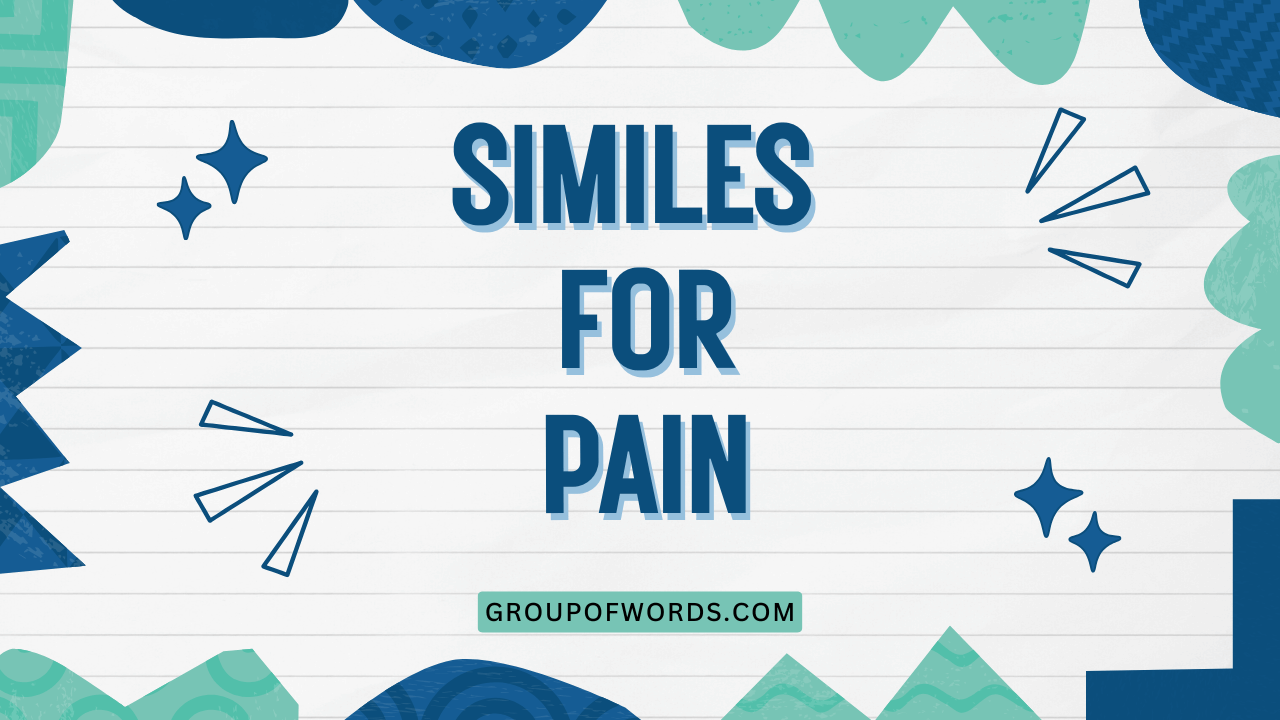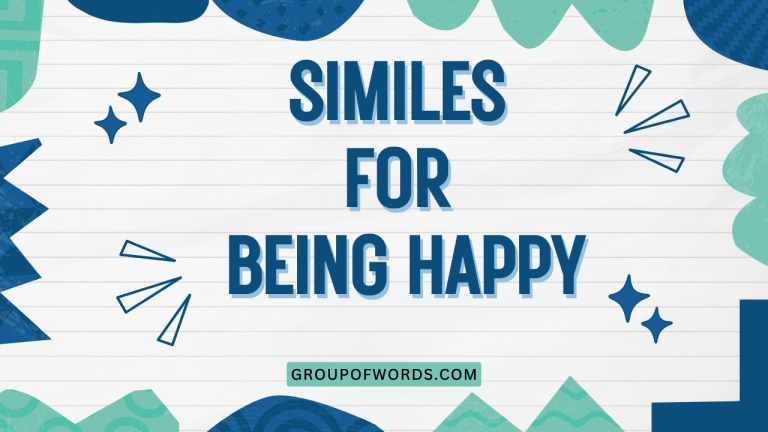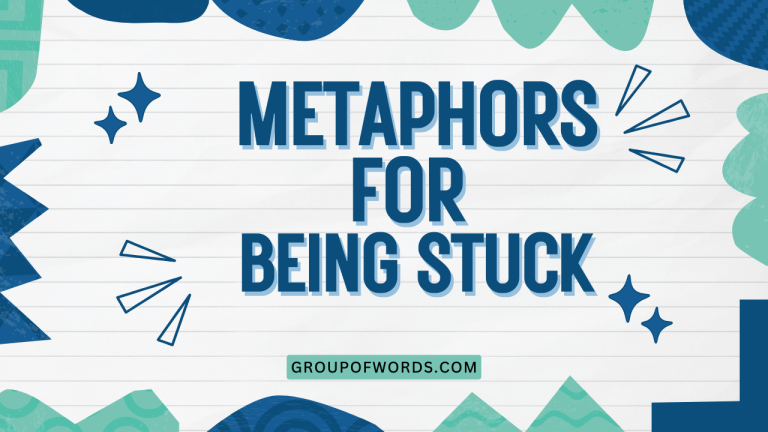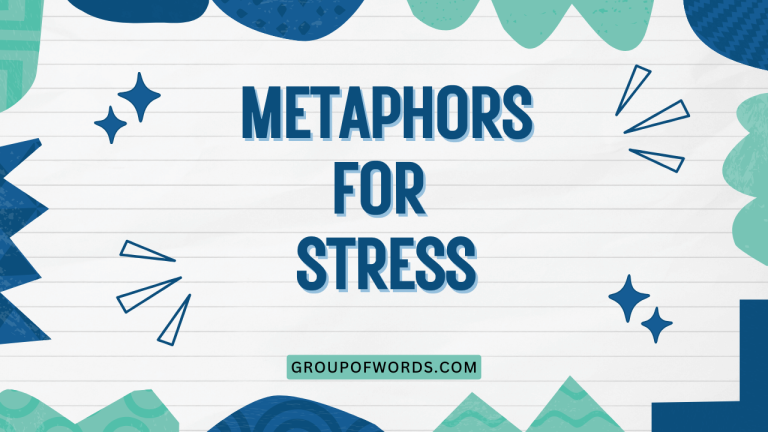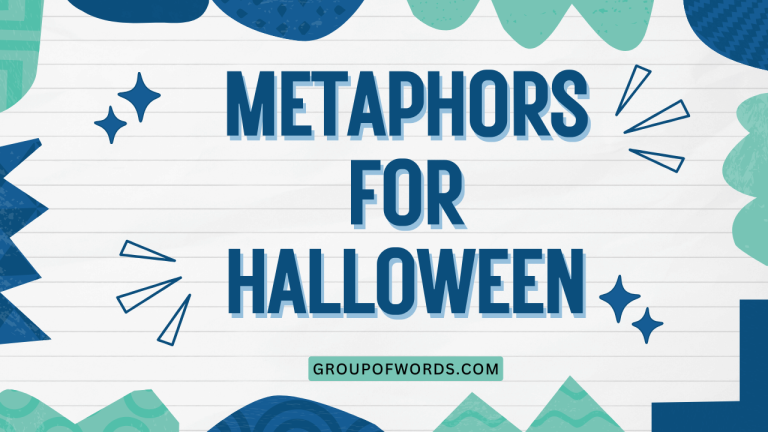Similes for Pain: A Comprehensive Guide to Expressing Discomfort
Understanding how to effectively describe pain is crucial for clear communication, whether you’re discussing personal experiences, writing creatively, or providing medical information. Similes, which compare one thing to another using “like” or “as,” offer a powerful tool for conveying the intensity, quality, and nature of pain.
This article explores the diverse world of similes for pain, providing definitions, structural breakdowns, examples, usage rules, and practical exercises to help you master this essential aspect of English expression. This guide will benefit students, writers, healthcare professionals, and anyone seeking to articulate their experiences more vividly.
Table of Contents
- Introduction
- Definition of Simile for Pain
- Structural Breakdown
- Types of Pain Described by Similes
- Examples of Similes for Pain
- Usage Rules
- Common Mistakes
- Practice Exercises
- Advanced Topics
- FAQ
- Conclusion
Definition of Simile for Pain
A simile is a figure of speech that compares two unlike things using the words “like” or “as.” In the context of pain, similes serve to illustrate the often-subjective experience of discomfort by relating it to something more tangible and relatable. This allows for a more vivid and nuanced description than simply stating “I am in pain.” Similes can convey not only the intensity of the pain but also its specific qualities, such as sharpness, dullness, throbbing, or burning.
The function of a simile for pain is primarily descriptive, aiming to evoke a specific sensation in the listener or reader. It allows for a deeper understanding of the pain being experienced, bridging the gap between the sufferer and the observer.
Similes are frequently used in literature, personal narratives, and medical settings to enhance communication and empathy. They are also used in everyday conversation to express oneself.
Similes for pain can be used in various contexts, including:
- Medical descriptions: Patients use similes to describe their symptoms to doctors.
- Creative writing: Authors use similes to create vivid imagery and evoke emotional responses.
- Personal narratives: Individuals use similes to share their experiences with others.
Structural Breakdown
The basic structure of a simile for pain follows a simple pattern:
Pain + “like” or “as” + Something Else (the Comparator)
Let’s break down the components:
- Pain: This is the subject being described. It can be a specific type of pain (e.g., “headache,” “stomach ache”) or a more general feeling of discomfort.
- “Like” or “as”: These are the connecting words that signal a comparison.
- Something Else (the Comparator): This is the object, concept, or experience to which the pain is being compared. The effectiveness of the simile depends on the reader’s ability to relate to the comparator and understand its connection to the pain.
For example:
“My headache felt like a hammer pounding inside my skull.”
In this example:
- Pain: headache
- “Like”: The connecting word
- Something Else (the Comparator): a hammer pounding inside my skull
The comparator is crucial. It should be something that most people can relate to or imagine, allowing them to understand the intensity and quality of the pain.
Strong similes rely on vivid and evocative comparators.
Types of Pain Described by Similes
Similes can be used to describe a wide range of pain experiences, both physical and emotional.
Physical Pain
Physical pain refers to discomfort experienced in the body. Similes are particularly useful for describing the specific sensations associated with different types of physical pain.
These similes often focus on the intensity, location, and quality of the pain. For example, sharp pain might be compared to a stabbing sensation, while dull pain might be compared to a throbbing ache.
Emotional Pain
Emotional pain refers to the distress and suffering experienced as a result of negative emotions, such as grief, sadness, anger, or anxiety. Similes can be used to capture the intangible nature of emotional pain, making it more relatable and understandable.
These similes often draw parallels between emotional pain and physical sensations or external forces. For example, heartbreak might be compared to a crushing weight, while loneliness might be compared to a vast emptiness.
Examples of Similes for Pain
Here are some examples of similes used to describe different types of pain, categorized for clarity.
Physical Pain Examples
The following table illustrates similes used to describe various types of physical pain, focusing on different sensations and intensities.
| Type of Pain | Simile |
|---|---|
| Headache | My headache felt like a vise tightening around my head. |
| Headache | The pain in my head was like a thousand tiny hammers hitting my skull. |
| Headache | It felt like my brain was being squeezed as if in a lemon squeezer. |
| Stomach ache | My stomach ache felt like knives twisting inside me. |
| Stomach ache | The cramping was as relentless as a washing machine on spin cycle |
| Muscle pain | My muscles were as stiff as boards after the workout. |
| Muscle pain | It felt like someone had beaten me with a baseball bat. |
| Joint pain | My joints felt like they were filled with sand. |
| Joint pain | Moving my knee was like grinding two rocks together. |
| Toothache | My toothache felt like a constant, throbbing pulse of agony. |
| Toothache | The pain shot through my jaw like an electric shock |
| Burn | The burn felt like fire ants crawling all over my skin. |
| Burn | The sun burned my skin as if it were trying to peel it off. |
| Cut | The cut felt like a hot wire slicing through my flesh. |
| Cut | It stung as if I poured acid on it. |
| Back pain | My back pain felt like a rusty hinge that needed oiling. |
| Back pain | A sharp pain shot up my spine like a lightning bolt. |
| Fracture | The broken bone felt like shattered glass grinding together. |
| Fracture | It was as if someone had driven a wedge into my bone. |
| Sore throat | My sore throat felt like swallowing razor blades. |
| Sore throat | It felt like sandpaper rubbing against my throat. |
| Labor Pain | The contractions came like waves crashing onto a shore. |
| Labor Pain | Each surge of pain was like an unbearable pressure building up, threatening to break me. |
| Arthritis | My arthritic joints feel like rusty hinges, creaking and groaning with every movement. |
| Arthritis | The pain in my hands is like tiny needles constantly pricking my skin. |
| Sciatica | The pain shot down my leg like an electric current, leaving a trail of fire in its wake. |
| Sciatica | It felt like someone was pulling a tight wire from my back down to my toes. |
These examples demonstrate how similes can effectively convey the specific qualities of different types of physical pain, making the experience more relatable to others. The use of vivid imagery helps the listener or reader understand the intensity and nature of the discomfort.
Emotional Pain Examples
The following table illustrates similes used to describe various types of emotional pain, focusing on feelings of sadness, loss, and despair.
| Type of Pain | Simile |
|---|---|
| Heartbreak | My heart felt like it had been ripped out of my chest. |
| Heartbreak | The pain of the breakup was like a deep, festering wound. |
| Grief | Grief washed over me like a tidal wave. |
| Grief | The loss was like a dark cloud that never lifted. |
| Loneliness | Loneliness felt like a vast, empty desert. |
| Loneliness | Being alone was like being lost in a dark forest. |
| Anxiety | Anxiety felt like a swarm of bees buzzing in my head. |
| Anxiety | My anxiety was like a tightrope walker on a high wire. |
| Depression | Depression felt like a heavy weight pressing down on me. |
| Depression | The world seemed as gray as a never-ending rainstorm. |
| Guilt | Guilt felt like a constant gnawing at my conscience. |
| Guilt | My conscience was as heavy as lead. |
| Shame | Shame felt like a burning brand on my forehead. |
| Shame | I wanted to disappear, like a shadow fading into the darkness. |
| Fear | Fear gripped me like a cold hand. |
| Fear | My heart pounded like a drum as I anticipated the danger. |
| Disappointment | Disappointment tasted like ashes in my mouth. |
| Disappointment | My hopes were shattered, like a glass vase dropped on the floor. |
| Regret | Regret lingered like a ghost from the past. |
| Regret | The “what ifs” haunted me like persistent whispers. |
| Betrayal | Betrayal felt like a knife in the back. |
| Betrayal | The trust was broken, like a fragile promise easily shattered. |
| Embarrassment | Embarrassment washed over me like a wave of heat. |
| Embarrassment | I wanted to crawl into a hole and disappear, as small as an ant. |
| Frustration | Frustration built up like a pressure cooker about to explode. |
| Frustration | I felt like banging my head against a wall, as nothing seemed to work. |
These examples illustrate how similes can be used to capture the intangible nature of emotional pain, making it more relatable and understandable. The use of vivid imagery helps the listener or reader empathize with the person experiencing the pain.
Combined Physical and Emotional Pain Examples
Sometimes, pain can be both physical and emotional, intertwined and difficult to separate. The following table provides examples of similes that capture this combined experience.
| Type of Pain | Simile |
|---|---|
| Loss of a loved one (physical exhaustion and grief) | The grief weighed on me like a physical burden, and my body felt as heavy as lead. |
| Chronic illness (physical discomfort and emotional despair) | Living with this illness is like being trapped in a body that’s slowly falling apart, while my spirit feels as if it’s withering away. |
| Traumatic injury (physical pain and emotional trauma) | The pain from the injury was like a constant reminder of the trauma, and my mind replayed the event like a broken record. |
| Burnout (physical fatigue and emotional exhaustion) | Burnout felt like running a marathon with a broken leg, and my motivation was as depleted as a dried-up well. |
| Depression (physical lethargy and emotional numbness) | Depression felt like wading through thick mud, and my emotions were as muted as a silent movie. |
| Anxiety (physical tension and emotional worry) | Anxiety felt like a knot tightening in my stomach, and my thoughts raced as fast as a runaway train. |
| Social Isolation (physical inactivity and emotional loneliness) | Being isolated felt like being stranded on a deserted island, and my heart ached as empty as a hollow shell. |
| Abusive Relationship (physical harm and emotional manipulation) | Being in that relationship was like walking on eggshells, and my self-esteem felt as fragile as a shattered mirror. |
| Grief and Physical Illness | The grief settled in my chest like a heavy stone, and my energy drained away as quickly as water through a sieve. |
| Postpartum Depression (physical recovery and emotional distress) | Recovering from childbirth while battling postpartum depression felt like climbing a mountain with weights chained to my ankles, and my joy felt as distant as a forgotten dream. |
| Witnessing a Tragedy (physical shock and emotional horror) | Watching the tragedy unfold was like having the air knocked out of me, and my mind reeled as if caught in a violent storm. |
| Financial Stress (physical stress and emotional anxiety) | The stress of financial insecurity felt like a noose tightening around my neck, and my hope dwindled as quickly as a melting candle. |
| Loss of Mobility (physical limitation and emotional frustration) | Losing my mobility felt like being confined to a prison, and my independence slipped away as easily as sand through my fingers. |
| Bullying (physical fear and emotional humiliation) | Being bullied felt like being hunted by predators, and my confidence shattered like thin ice under heavy footsteps. |
| Discrimination (physical exhaustion from fighting and emotional anger) | Fighting against discrimination felt like running against a constant headwind, and my anger burned as fiercely as a wildfire. |
| Addiction (physical cravings and emotional dependence) | Addiction felt like being chained to a monster, and my willpower crumbled as easily as a house of cards. |
| Miscarriage (physical trauma and emotional devastation) | The miscarriage felt like having my dreams ripped away, and my heart ached as empty as a barren field. |
| Job Loss (physical stress and emotional uncertainty) | Losing my job felt like having the rug pulled out from under me, and my security vanished as quickly as a puff of smoke. |
These examples illustrate the complex interplay between physical and emotional pain and how similes can effectively capture this combined experience. The use of vivid imagery helps the listener or reader grasp the full impact of the suffering.
Usage Rules
When using similes for pain, keep the following rules in mind:
- Clarity: Ensure that the comparison is clear and easy to understand. The reader should be able to readily connect the pain to the comparator.
- Relevance: The comparator should be relevant to the type of pain being described. A sharp pain, for example, might be compared to a knife or a needle, while a dull pain might be compared to a throbbing ache.
- Vividness: Use vivid and evocative language to create a strong mental image in the reader’s mind. The more specific and detailed the comparator, the more effective the simile will be.
- Originality: Try to avoid clichés and overused similes. Strive for originality to make your writing more engaging and memorable.
- Context: Consider the context in which you are using the simile. The appropriateness of a simile may vary depending on the audience and the purpose of the communication.
Example of a good simile: “The throbbing in my leg was like a persistent drumbeat, never ceasing.” (Clear, relevant, vivid)
Example of a weak simile: “The pain was like something bad.” (Unclear, irrelevant, not vivid)
Common Mistakes
Here are some common mistakes to avoid when using similes for pain:
| Mistake | Incorrect Example | Correct Example |
|---|---|---|
| Using a cliché | My headache was like hell. | My headache felt like my brain was being squeezed in a vise. |
| Using an unclear comparison | The pain was like a thing. | The pain was like a hot poker stabbing my eye. |
| Using an irrelevant comparison | My stomach ache was like a sunny day. | My stomach ache felt like knives twisting inside me. |
| Mixing metaphors and similes | The pain was a raging fire, like an inferno. | The pain was like a raging fire. (Simile) OR The pain was a raging fire. (Metaphor) |
| Overusing similes | The pain was like this, and like that, and like everything else. | Use similes sparingly to maximize their impact. |
Avoiding these common mistakes will help you use similes for pain more effectively and create more impactful writing.
Practice Exercises
Test your understanding of similes for pain with the following exercises.
Exercise 1: Identify the Simile
Identify the simile in each of the following sentences.
| Question | Answer |
|---|---|
| 1. The burn on my hand felt like fire ants crawling all over it. | like fire ants crawling all over it |
| 2. Her heart was breaking. | (No simile – this is a metaphor) |
| 3. The grief washed over him like a tidal wave. | like a tidal wave |
| 4. The pain in his back was excruciating. | (No simile) |
| 5. The loneliness felt like a vast, empty desert. | like a vast, empty desert |
| 6. The cut stung as if acid was poured on it. | as if acid was poured on it |
| 7. The headache felt like a hammer pounding my skull. | like a hammer pounding my skull |
| 8. The news hit him like a ton of bricks. | like a ton of bricks |
| 9. The ache was dull and persistent. | (No simile) |
| 10. Her anger was a simmering volcano. | (No simile – this is a metaphor) |
Exercise 2: Complete the Simile
Complete the following similes with an appropriate comparison.
| Question | Answer |
|---|---|
| 1. My headache felt like __________. | a vise tightening around my head |
| 2. The pain in my stomach was like __________. | knives twisting inside me |
| 3. The loneliness felt like __________. | being lost in a dark forest |
| 4. The burn on my skin felt like __________. | fire ants crawling all over it |
| 5. The grief washed over me like __________. | a tidal wave |
| 6. My muscles were as stiff as __________. | boards |
| 7. The cut stung as if __________. | acid was poured on it |
| 8. My anxiety felt like __________. | a swarm of bees buzzing in my head |
| 9. The rejection felt like __________. | a slap in the face |
| 10. The disappointment tasted like __________. | ashes in my mouth |
Exercise 3: Write Your Own Similes
Write your own similes to describe the following types of pain.
| Type of Pain | Your Simile |
|---|---|
| 1. A throbbing toothache | (Answers will vary) Example: My toothache felt like a drumbeat of pain in my jaw. |
| 2. The feeling of intense sadness | (Answers will vary) Example: The intense sadness felt like a heavy rain cloud looming over my entire being. |
| 3. A sharp, stabbing pain in your side | (Answers will vary) Example: The sharp pain in my side was like a dagger twisting with each breath. |
| 4. The feeling of overwhelming anxiety | (Answers will vary) Example: Overwhelming anxiety felt like a thousand butterflies trapped in my chest. |
| 5. The ache of loneliness | (Answers will vary) Example: The ache of loneliness felt like an echoing silence in a crowded room. |
| 6. The burn of betrayal | (Answers will vary) Example: The burn of betrayal felt like acid eating away at my trust. |
| 7. The stiffness of arthritis in the morning | (Answers will vary) Example: The stiffness of arthritis in the morning felt like my joints were frozen in place. |
| 8. The exhaustion from burnout | (Answers will vary) Example: The exhaustion from burnout felt like my energy reserves had been completely drained dry. |
| 9. The frustration of writer’s block | (Answers will vary) Example: The frustration of writer’s block felt like a wall blocking every creative thought. |
| 10. The disappointment of a failed attempt | (Answers will vary) Example: The disappointment of a failed attempt tasted like stale bread, leaving a bitter aftertaste. |
Advanced Topics
For advanced learners, consider the following:
- Extended Similes: Develop a simile over several sentences or paragraphs to create a more detailed and impactful description.
- Juxtaposition: Use similes that compare pain to something unexpected or contrasting to create a surprising effect.
- Subtlety: Explore using subtle similes that hint at the pain rather than explicitly describing it.
For example:
“The grief settled in her chest, a cold, heavy stone. It was like a winter that wouldn’t end, a perpetual twilight that dimmed the colors of the world. Each breath was a struggle, like trying to fill lungs that had been emptied of air.” (Extended Simile)
FAQ
Here are some frequently asked questions about similes for pain.
- What is the difference between a simile and a metaphor?
A simile compares two things using “like” or “as,” while a metaphor states that one thing *is* another. For example, “The pain was like a knife” (simile) vs. “The pain was a knife” (metaphor).
- Why use similes instead of directly describing pain?
Similes can provide a more vivid and relatable description of pain, allowing the listener or reader to better understand the experience. They add depth and nuance to your writing.
- How can I avoid using clichés when creating similes?
Think about specific details and unique comparisons. Try to relate the pain to something personal or unusual to make the simile more original.
- Can similes be used for both physical and emotional pain?
Yes, similes are effective for describing both physical and emotional pain. The key is to choose a comparator that accurately reflects the specific sensation or feeling.
- How many similes should I use in a piece of writing?
Use similes sparingly to maximize their impact. Overusing similes can make your writing feel cluttered and repetitive.
- What makes a simile “good” or “effective”?
A good simile is clear, relevant, vivid, and original. It should create a strong mental image in the reader’s mind and accurately convey the nature of the pain being described.
- Are there specific types of pain that are easier or harder to describe with similes?
Subjective experiences such as emotional pain can be harder to describe than physical pain because they are less tangible. The key is to find a comparison that resonates with the reader’s understanding of emotions.
- How do I choose the right words when creating a simile?
Consider the intensity, quality, and location of the pain. Use descriptive adjectives and nouns that evoke a specific sensation or feeling in the reader’s mind. A thesaurus can be helpful for finding more vivid and precise language.
Conclusion
Mastering the use of similes for pain is a valuable skill for effective communication and creative expression. By understanding the structure, types, and usage rules of similes, you can vividly convey the experience of pain to others.
Practice using similes in your writing and conversations to enhance your descriptive abilities and create more impactful communication. Remember to be clear, relevant, vivid, and original in your comparisons, and avoid common mistakes like using clichés or irrelevant comparators.
By continuously refining your understanding and application of similes, you’ll be well-equipped to articulate the complexities of pain, fostering greater understanding and empathy in your interactions. Continue to explore diverse examples, experiment with your own creative expressions, and refine your ability to choose impactful comparators.
